The sound of air being forcibly expelled from the human body, usually represented in print as oof or umph or something along those lines, is unmistakable. And when I heard it from the area close behind me where my wife, Joan, was picking her way towards the happily murmuring waters of Grouse Creek, I had a pretty good idea, before I turned around for visual confirmation, of what had happened. This particular stretch of the bank is booby-trapped with sizeable logs lurking hidden, or nearly so, beneath the marsh grass; in fact, I’d warned Joan literally seconds earlier to watch her step.
No matter: She tripped anyway.
I turned to see her sprawled face-down in the tall grass, a posture that suggested any number of possibilities, none of them good. (At least she wasn’t carrying the rod.) Although fit and sturdily put-together, Joan is a petite “senior” woman, a category that puts her at heightened risk for broken bones. I’m not one to jump to conclusions, but it wasn’t lost on me that effecting a Medevac from where we were—a remote, off-road brook trout stream in the Wisconsin Northwoods—would be a logistically daunting proposition.
“Um, are you OK?” I asked, lamely.
She just groaned. Even more alarmingly, for another second or two she didn’t move. But then she said “I’m all right,” got her arms beneath her, and pushed herself to her knees. I offered a steadying hand and helped her to her feet. Her left wrist was a little sore but she was more embarrassed than anything.
“I don’t know what happened,” she said. “I was trying to be careful, but all of a sudden I was falling, and there was nothing I could do about it.”
“Welcome to my world,” I said with a laugh. “That happens all the time grouse hunting. One minute you’re upright, the next you’re flat on your face.”
“I remember,” she said, perking up. “That’s why I only went grouse hunting with you once!”
Then she rubbed her wrist, straightened her Great Lakes cap (“Unsalted and Shark Free”), looked at the creek, looked back at me, and said, “Are we going to fish or what?”
She’s a trouper, that one.
The hunt Joan referred to took place some 30 years ago. But if grouse hunting didn’t stick, fly fishing for trout—an interest she developed early in our courtship—did. I was over-the-moon when she suggested that instead of an engagement ring (it wasn’t the first rodeo for either of us) I could get her a good fly rod—a five-weight Scott G-series, to be exact.
For the record, she ended up getting the fly rod and the ring.
Joan even traveled to the Catskills, along with a couple of girlfriends, to attend the Joan Wulff School of Fly-Fishing, at the time the most renowned institution of its kind. She was mostly interested in learning how to cast, and in those days there was no better place to do it.
We got out a few times after that, but then, before the lessons Joan learned at the knee of Ms. Wulff had a chance to ingrain themselves in her muscle memory, life got in the way. Daughter, career, home ownership, health challenges, aging parent, grandchildren—round up the usual suspects. The upshot is that she didn’t pick up a fly rod again for 25 years, although I took it upon myself to see that her Scott got regular exercise, especially during the Hex hatch.
The ember of Joan’s trouty aspirations continued to glow, however, and when she retired, after a distinguished 41-year career as an academic librarian at the University of Wisconsin-Green Bay (distinguished in the minds of everyone who worked with her, anyway, if not in her own), circling back to fly-fishing was one of her priorities. I got the ball rolling by giving her spiffy new Orvis waders and wading boots for Christmas; then, once spring had sprung, she took casting lessons from Pam Van Erem, a superb instructor who’s just about the kindest, most patient human being this side of the Dalai Lama. When I told one of Pam’s colleagues at the Tight Lines Fly Shop that Joan had taken casting lessons from her, he laughed and said, “I hear she yells a lot.”
Still, the ability to make a crisp, string-straight cast on the mowed lawn of a city park correlates imperfectly, at best, with the ability to make that same cast, or even a reasonable approximation thereof, while standing in moving water and having to contend with trees, brush, tall grass, and other malign obstructions. To say nothing of controlling your line, keeping your fly in the “strike zone,” and presenting it in such a way that a trout might possibly be inclined to eat it.
That’s a whole other ball game, as they say.
With these considerations in mind, a couple of northern Wisconsin brook trout streams stood out as the best places—the best ones I knew of, anyway—for Joan to get her feet wet. Grouse Creek, previously mentioned, was one; Potato Creek was the other. (These are not their real names, so don’t bother trying to find them.) Both boast healthy populations of scrappy native brookies (a testament to the tremendous dedication of the Wisconsin DNR’s trout managers); both were places where Joan could reasonably expect to catch fish, have fun doing it, and at the same time develop her skills and confidence in a low-stress, low-pressure environment.
Plus, the wading’s not terribly difficult, there’s generally (though not always) room for a backcast, and a simple quartering downstream cast with a wet fly—a presentation with a healthy margin for error—works as well as anything. Competition from other anglers is typically light to nonexistent, and the scenery’s not bad, either.
It seemed like a pretty solid recipe for success—and that’s the way it’s worked out. It’s a bit of a drive to both of these streams—100 miles to Potato Creek, 125 to Grouse Creek—so we try to get as early a start as possible in order to fish in the cool of the morning before the sun gets too high. (“Cooler is always better for brookies,” I mansplained.) We pack sandwiches, chips, and, at Joan’s insistence, raw veggies, and when we’re done fishing, typically after about three hours or so, we find a scenic spot, preferably near moving water, for an alfresco lunch. A cold beer would taste great but, alert to the very real possibility of waking up upside-down in a ditch on the drive home, I settle for cold water instead.
Our m.o. is to share a rod, with Joan fishing the more open stretches and me taking over in the tighter, brushier areas. Every so often, too, if I see a spot that I know will be a tough chance for her, I’ll ask for the rod and try to bend one in. Joan’s always impressed when one of these casts results in a take, and what man, warmed by the glow of his romantic partner’s admiring gaze, doesn’t find himself puffing out his chest a little?
Said rod, by the way, is not the five-weight wedding rod—that’d be too much gun for these creeks—but a 7’7” three-weight, also a Scott, that’s about as good a small stream rod as there is, in my opinion.
I try to stay patient, keep my coaching to a minimum, and let Joan figure things out for herself. She occasionally needs to be reminded to wait a beat on her backcast—sound familiar, anyone?—also to aim her casts at an angle to the current so that the fly “swings,” thus covering more water and appearing more lifelike to the trout (although with brookies, God bless ‘em, this doesn’t always matter). Keeping the line tight so that she can feel the strike, and react to it, is another work-in-progress—and a reminder to me of how many things we “experienced” anglers do without thinking, not all of which are intuitive to beginners.
When a branch grabs Joan’s fly I assure her that it’s par for the course and that she shouldn’t get frustrated; ditto when she misses a strike, with the added caveat that brookies often hit so quickly that unless they hook themselves there’s really not much you can do. Her casting has improved with every outing, but what’s even more gratifying is the way she’s learned to read the water, recognize the “fishy” areas, and deliver her fly in such a way that it swings through them enticingly—just the way it’s supposed to. She’s still a little unsure of what to do when she actually hooks a fish, but that’ll come.
The bottom line is that I’m confident, at this point, that Joan could catch brookies on either of these streams without my help—although she admits she’d be in trouble if she lost a fly and had to tie on a new one. As she sheepishly confessed upon her return from the Joan Wulff School those many years ago, “I skipped the knot-tying class.”
Maybe once a year, during Joan’s hiatus from fly-fishing, I’d bring home a few brookies for the pan. One of my oft-repeated maxims is “There’s only one thing better than fresh brook trout sautéed in butter: fresh brook trout pan-fried in bacon fat.” While Joan probably wouldn’t go that far, a meal of brook trout rated pretty highly on her scale of gustatory enthusiasms.
But now that she’s felt their living throb on the end of her line, held that cool, jewel-like lozenge in her hand and gazed in bewildered awe at those wondrous, intricately patterned colors, her days of eating brook trout are over. When I remarked that a brookie she’d landed was the perfect size for the pan, she regarded me fiercely and said, “I want to see them swim away.”





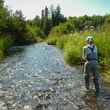





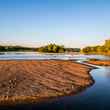




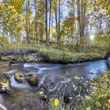




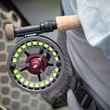
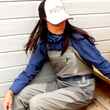




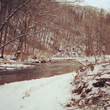

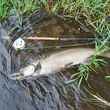
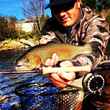
Comments